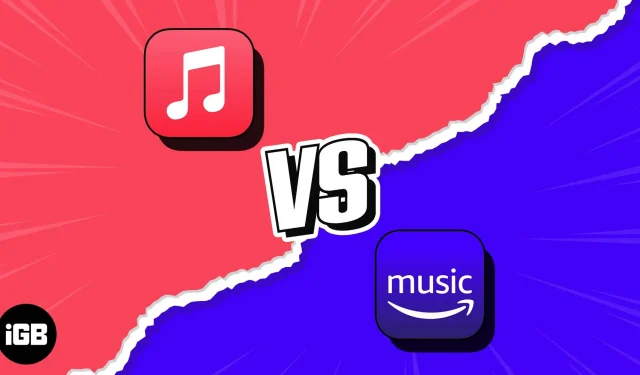I just tried out Apple Music and Amazon Music, two of the most well-liked music streaming services offered on the App Store, as a music enthusiast and iPhone user. Both apps have large music collections, custom playlists, and offline listening options. But as I looked more closely at each service, I found some clear distinctions.
I’ll discuss my personal experience and offer a thorough comparison between Apple Music versus Amazon Music in this editorial. Read on to see which one I believe is the best for iPhone users and why, whether you’re trying to pick between the two services or are just interested about how they compare.
Comparison of Apple Music and Amazon Music in-depth
It’s crucial to compare the general user experience, pricing, music library, available material, etc. when contrasting Apple Music with Amazon Music. Apple Music offers exclusive material like live radio stations and original shows, and it integrates with the Apple ecosystem without any hiccups.
Amazon Music, on the other hand, has a more reasonable price plan that includes a free, ad-supported tier. Being a Prime member, I also received a lower-cost subscription plan. For individuals who frequently use voice assistants, Amazon Music is a fantastic option because Alexa is embedded right in.
Let’s investigate each parameter to determine which one ultimately prevails.
1. Plans for subscription
I received a 6-month free subscription to Apple Music when I purchased my AirPods Pro. After that, $10.99 per month was charged. I contemplated moving to a Family Plan, which costs $16.99 each month, as it seemed expensive to me. My other family members could thereby benefit from the premium service for a single price. In comparison, I signed up for Amazon Music Free first before choosing the Individual Plan, which costs $8.99 per month.
I’ve included the entire pricing table for a clearer picture:
| Apple Music | Amazon Music Unlimited | |
| Starting Price | $10.99/month | Free |
| Individual Plan | $10.99/month | Non-Prime: $10.99/month Prime: $8.99/month |
| Student Price | $5.99/month | Non-Prime: $5.99/month Prime: $0.99/month |
| Family Package | $16.99/month | $15.99/month or $159/year (Prime members only) |
| Annual Plan | $109/year | $89/year (Prime members only) |
| Others | Voice Plan: $4.99/month | Single Device Plan: $4.99/month |
At first sight, it could appear that Amazon Music has the most affordable subscription rates. Nevertheless, remember that Prime costs $139 a year. It therefore costs significantly more than Apple Music when the $89 annual fee for the Unlimited membership for Prime subscribers is included. But, as a qualified student, my brother receives the premium for just $0.99 a month.
Additionally, Unlimited is only $4.99 per month if you have an Amazon Echo device and are a Prime member. Your subscription, however, will be limited to one speaker. Not to mention, Amazon provides a Family Ultimate Plan for six people for $15.99 each month.
Despite recent pricing increases by Apple, I believe it to be more inexpensive than Amazon Music Unlimited. This is due to the fact that you are not required to purchase a second membership. Not to be overlooked are the advantages of having an Apple One plan. Contrary to what many people think, Apple Music offers better and more affordable overall subscriptions.
Winner: Apple Music
2. No-cost trials
When in doubt, always choose a free trial, is my motto. And in this scenario, Apple Music makes for the perfect test subject. You may obtain a lengthy free trial of Apple Music in a number of ways. Apple typically offers a one-month free trial, but if you buy an eligible Apple device, you can receive 6 months for free and Shazam will give you 3 months for free.
I have an Apple One subscription, therefore I can use Apple Music for free. Amazon does provide a free trial for their subscription music service, but it only lasts for 30 days before fees are assessed.
Winner: Apple Music
3. User interface
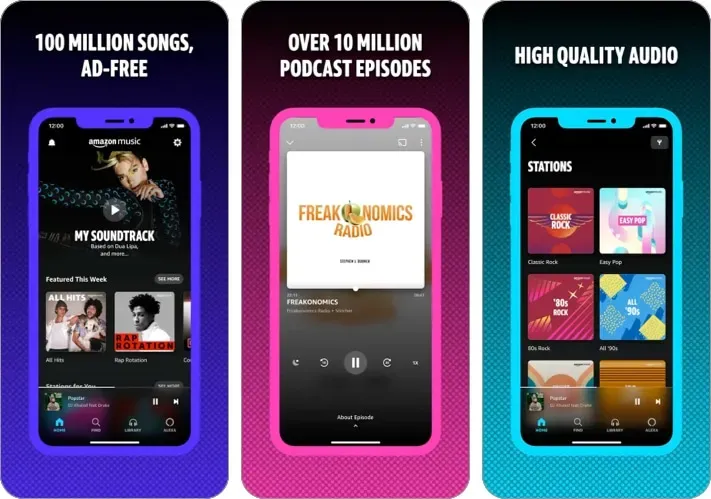
Apple Music’s user interface is traditional: it is uncomplicated, attractive, and light. It provides a handy drag-and-drop functionality for adding tunes to different playlists. The best feature is that all playlists are grouped into categories for easy viewing. In comparison, Spotify’s design is more like Amazon Music’s thanks to its tiny tiles and vivid letters against a dark background.
There isn’t much of a functional difference between the two apps overall, other from the tiny style differences. However, because Amazon Music’s Find page is organized by genre structure, which I find more appealing, it makes more sense to me whenever I’m looking for new music.
Since the user experience entirely depends on individual preferences, I am unable to choose a winner in this circumstance. I feel more at home at Apple Music as a devoted Apple user.
Winner: Tie
4. Music library
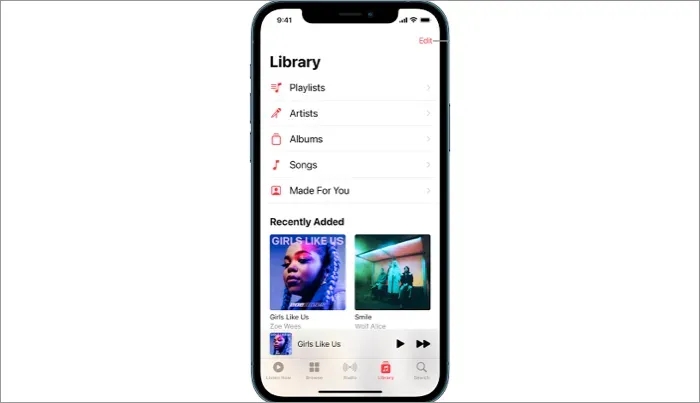
There are 100 million songs available on Apple Music and Amazon Music. Apple also offers over 30,000 playlists that have been expertly curated, in addition to original programming, live and on-demand radio stations hosted by artists, concerts, and other events. Recently, I developed a liking for Apple Music Classical, which boasts the biggest collection of classical music.
The ‘Browse’ section of Apple Music contains hundreds of carefully picked song categories. I find it easy to stay up to date on all the newest releases thanks to playlists like Today’s Hits, New Music Daily, and Daily Top 100. Together with independent artist playlists, video playlists, and stations, Apple Music also provides a wide variety of niche music.
By having specially crafted mood playlists, Apple Music also assisted me in improving my mood. As the program allows you to select a handful of your favorite artists when you join up, the customizing algorithm is fantastic. Apple Music then tailors playlists, the daily mix, and the For You section with new releases based on your preferences.
Don’t worry about missing out on new releases; you’re likely to find the same songs on Amazon Music. However, given that only a few categories are accessible in the Home section of Amazon Music, it places a greater emphasis on “popular” music tracks. It seemed to me more like “best of the best” compilations created from the app’s most popular content.
There are a total of 12 playlist categories that cover the most well-liked genres, including Pop Culture, Rap Rotation, and All Hits. I had to look hard to find these particular tracks because there was no independent or niche music featured. Additionally, mood playlists and world music charts are absent from Amazon Music, and the accuracy of the suggestion system is subpar.
Winner: Apple Music
5. A range of well chosen content
Both services continue to offer non-music content including videos, podcasts, talk shows, etc. under their respective individual brands.
In addition to music, I regularly listen to podcasts, and Amazon Music makes it simple to do so because it has a section only for podcasts that features 70,000 distinct programmes. Additionally, it provides access to interviews, playlists of music videos, live performances, and special sessions like “Prime Day Show.” Sadly, Apple did not offer many podcasts on its Music app and instead created a different app for this purpose.
Both sites employ curated content in a very similar way, analyzing your listening habits to produce playlists that combine your favorite songs with recently released music they think you’ll enjoy. Create playlists based on genres and even the time of day, such as choosing upbeat music to get you moving in the morning, and use those playlists to listen to music.
Winner: Amazon Music
6. Quality for streaming
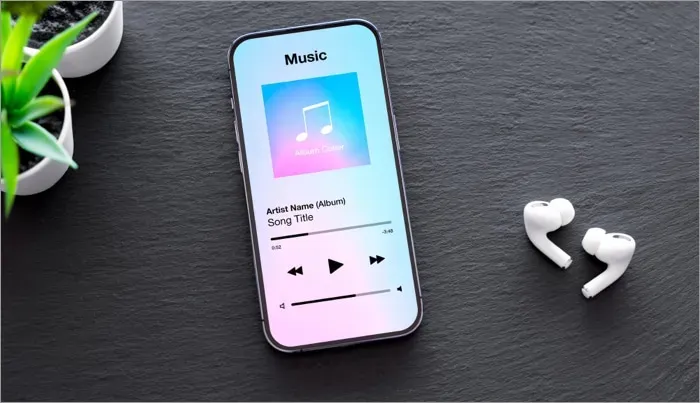
Apple Music has superior audio quality in terms of resolution and bit rate. It distinguishes itself with Real Hi-Res Audio and lossless streaming at up to 24-bit/192kHz and “CD-quality” at 16-bit/44.1kHz. If lossless music isn’t your style, Apple Music offers the highest-quality 256kbps AAC files.
Additionally, it converts its music tracks to Lossless Audio using the ALAC (Apple Lossless Audio Codec) format, which preserves the original audio file’s data. As a result, the format in which they were originally recorded in the studio will be what you hear.
Similar to Apple Music, Amazon Music supports lossless audio at the same bitrate and Ultra HD video at high definition. Nevertheless, if you choose the Hi-Res Lossless grade, you’ll probably require an external DAC (digital-to-analog converter). Also, you have three options for audio quality (low, medium, and high), ranging from 48 Kbps to 320 Kbps.
Hence, the majority of the audio quality options for the iPhone are the same for both platforms. Even still, Apple outperforms Amazon Music in terms of 24-bit/48 kHz HD streaming quality.
Winner: Apple Music
7. Data usage
Data use is my main worry whenever I stream music using cellular data when I’m on the go. This is why I considered it while contrasting Apple Music and Amazon Music Unlimited.
While streaming in its native 256kbps AAC format, Apple Music utilizes about 200MB of Wi-Fi data or 75MB of cellular data each hour. On the other hand, Amazon Music makes no mention of the music format directly. But I believe it’s the common AAC or MP3 files.
At the highest settings on both systems, I used between 720 and 2900 MB of data per hour for the lossless options. Therefore, because of the improved audio quality and increased data usage, I experienced some playback issues while in a weak network region. Three to four seconds of lag and buffering were experienced.
Amazon Music provides a simple way to conserve data in order to reduce this high data consumption. You can enable Data Saving options or select low-quality audio streaming. Moreover, Apple Music allows you to preserve your mobile data, although this is a workaround and not a setting. In my experience, both systems’ playback in data-saver mode experienced very little to no lag.
You won’t hear much of a difference between the highest-quality streaming of the same music if you are not an audiophile, in my opinion. Thus, the ability to select the bitrate on Amazon Music may be useful if you’re worried about using up your mobile data plan.
Winner: Amazon Music
8. Using headphones

Without comparing the auditory immersion levels of each music streaming service, a comparison cannot be complete. Regarding 360-degree sound, Apple Music and Amazon Music have different features. Thanks to Dolby Atmos with Spatial Audio, I always have a satisfying listening experience. Even when used with headphones, it offers a virtual 3-D experience.
Amazon has partnered with Sony and added support for Sony 360 Reality Audio to improve the experience. You will also receive the Dolby Atmos functionality. But take note that Dolby Atmos playback is only enabled by the Amazon Echo Studio, while 360 Reality Audio is limited to the Echo Studio, Sony RA3000, and RA5000 speakers.
Apple Music is my preferred music app because I use them the most of the time.
Winner: Apple Music
9. Offline listening
Both Apple Music and Amazon Music Unlimited let you download 100,000 songs to your library and offer offline listening. Thanks to the iCloud Music Library function, you may access your Apple Music collection from any device. With the same Apple ID, you may sync any downloaded music across all of your devices.
However, Amazon Music doesn’t offer a similar useful feature. Users of Amazon Music Unlimited can download songs to a maximum of 10 devices. These devices cannot be synced in order to access or update your library.
Winner: Apple Music
10. Music sharing
You can share your personalized playlists with your friends and follow them on Apple Music. Also, the For You page will show what your friends are playing. Amazon Music Unlimited does allow you to exchange song links via SMS, albeit lacking these functionalities.
I favor Spotify over Apple Music and Amazon Music in terms of social media integration. I could post music tracks directly to the social network using the Amazon Music app, albeit there are some workarounds. On the other hand, I was limited to sharing music via AirDrop with Apple Music subscribers.
Winner: Amazon Music
11. Voice assistants and integration
Already my best buddy, Siri has now taken on the role of my personal DJ thanks to my Apple Music subscription. Using Siri, you can control what music is playing, queue up tracks, look up song information, add songs to your collection, play your favorite playlists, or even play something new. In order to improve the customer experience, Apple Music has customized Siri functions and automation.
If you own an Amazon Fire TV or Echo speakers, you can use Alexa, Amazon’s voice assistant. It has many of the same DJ features as Siri. I attempted to set up Apple Music so that it would play on Amazon Echo devices. There are no Alexa skills accessible, though, and the experience is less seamless.
On the other hand, Apple’s HomePod speakers and Apple TV 4K are made to be used with Apple Music. It has Siri functionality for playlist management and access. Only iPhones running the Amazon Music app can stream music to HomePod. However keep in mind that none of the other features won’t function.
Apple Music Siri shortcuts, in my opinion, are more practical, simple to use, and time-saving. If you are accustomed to Alexa, Amazon Music is the best option for you.
Winner: Tie
12. In-car experience
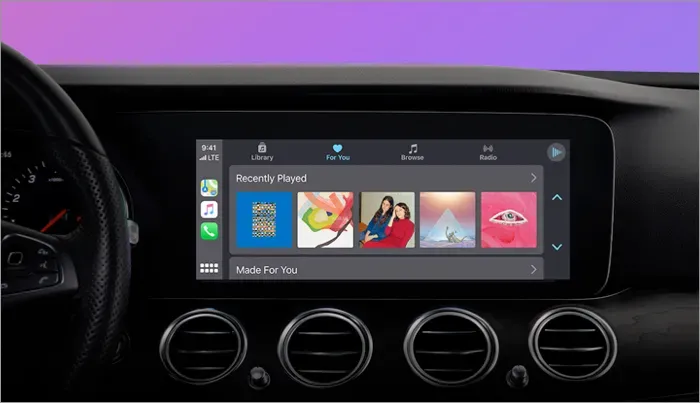
Apple’s CarPlay system works with both Apple Music and Amazon Music. If your car doesn’t support CarPlay, you can still stream Apple Music using an integrated app, Bluetooth, or a cable connection without using an external device.
Alexa Auto, which needs to be integrated, works best with Amazon Music. To stream Amazon Music on the go and improve your listening experience, you can get an Echo Car device.
Winner: Apple Music
13. Additional features
The majority of the features, including immersive sound, Dolby Atmos, an integrated equalization, song lyrics, etc., are the same on both music streaming services. Nonetheless, a few special features are accessible.
Apple Music
Due to its many more extra features and higher value as a purchase, Apple Music is outpacing other music streaming services. Under the Behind the Tracks section, Apple Music emphasizes the biographies of the musicians featured in particular playlists. The Apple Replay, which compiles your most-heard songs over the course of a year, is another feature I truly appreciate.
Moreover, Dolby Atmos’ Spatial Audio delivers listeners a more engrossing audio experience. Saylists, which fosters better speech articulation for persons with speech-sound impairments, is one of the unique characteristics (SSD).
Radio is Apple Music’s actual specialty. Three flagship channels are available under the Radio tab: Music 1, Music Hits, and Music Country. These stations stream live to 165 different nations. For the most recent in sports, news, interviews, and talk shows, you can also tune in to overseas channels.
Additionally, it offers carefully chosen music stations that are catered to your listening interests. I’ve made my own radio station on Apple Music for additional customization. Also, the most popular radio shows and playlists from previous years are kept under the Radio category.
Because of the karaoke functionality of Apple Music Sing, I also utilize it during my house parties. 5 new lyrical features make hitting every beat more fun. With real-time lyrics and versatile voices that let you sing solo, duet, or backing harmonies, you can perform popular tunes.
I can also watch concerts by my favorite singers from the comfort of my couch thanks to Apple Music Live. You can view any concert series that is currently airing to see original performances that were live-streamed.
Amazon Music Unlimited
I always visit Amazon Music’s Now Playing page’s more information section whenever I want more information on any particular song. The DJ Mode, which transforms the playlist into a hosted listening session, is another feature. Also, Amazon Music Live enables artists from across the world to broadcast their subscribers’ Twitch live streams.
Amazon Music offers radio stations as well, but unlike Apple Music, its selection is pathetic by default and you can’t create a station from a song, album, artist, or playlist.
Conclusion
The ultimate verdict in the Apple Music vs. Amazon Music comparison is now available. In most of my comparative criteria, Apple Music came out on top.
Both apps offer enormous music libraries and high-resolution lossless music. Additionally, a sizable amount of video content as well as other unique components like radio and live streams will be provided. However, both applications are still fairly competitive in terms of offering a top-notch listening experience. Everything that matters are your preferences and what is most practical for you.
Who should get Apple Music?
Apple Music provides more seamless device connectivity if you use an iPhone or other Apple device, like I do. The album covers are elegantly animated, and the user interface is exquisite. Apple Music Radio is also a great tool for people who enjoy listening to the radio. Also, if you want highly personalized playlists and original audio and video content, it is perfect.
Who should get Amazon Music?
If you’re already a Prime subscriber, the inexpensive Amazon Music subscriptions make sense. Even more so if you have a limited budget because the free plan is an option. The free plan, in my opinion, is overly ad-supported and has very few features. If having quick access to podcasts is important to you, Amazon Music is your best choice. Also, an Amazon Echo device will enhance your enjoyment of Amazon Music.
FAQs
Is it worth upgrading to Amazon Music Unlimited?
Amazon Music Unlimited is the best option if you already have a Prime subscription and Alexa-capable devices. You can download and share any of 100 million songs without being interrupted by advertisements. Amazon Music’s Free plan has several restrictions and is not suitable for audiophiles.
Is Amazon Prime Music the same as Amazon Music Unlimited?
An independent streaming music service with special features for a better listening experience is Amazon Music Unlimited. Contrarily, Amazon Music Prime does not offer streaming in HD, Ultra-HD, or spatial audio and is a perk of your Prime membership.
I’m hoping my assessment has aided in your decision-making. If you’re still perplexed, you may download both apps’ free trial versions and try them out.
Ava
Ava is an enthusiast technical writer coming from tech background. She loves to explore and research about new Apple products & accessories and help readers decode the tech with ease. Along with studying, her weekend plan includes binge-watching anime.
